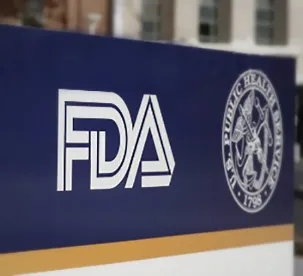On August 4, 2023, the Food and Drug Administration (“FDA”) Office of Prescription Drug Promotion (“OPDP”) issued a Warning Letter to AstraZeneca which stated that the company made misleading claims in a promotional sales aid about the effectiveness of BREZTRI AEROSPHERE™ (“Breztri”). Given that it has been almost a year and half since OPDP issued a Warning Letter (the last Warning Letter was issued in February 2022), the takeaways here are significant for industry and provide insight into how FDA will examine efficacy claims that are so-called “consistent with label” and require compliance with FDA’s June 2018 guidance (the “CFL Guidance”).[1],[2] Going forward, we expect the agency’s focus to remain on product communications to the public—to either a general consumer or professional audience—and whether those communications include essential contextual information to avoid the potential that such claims could be viewed as misleading.
The Drug and The Warning Letter
Breztri is a prescription inhaler, containing budesonide, glycopyrrolate, and formoterol fumarate, used for the maintenance treatment of chronic obstructive pulmonary disease (“COPD”), including chronic bronchitis, emphysema, or both, in adults. Although COPD cannot be cured, Breztri may help patients who experience difficulty breathing and flare-ups due to their COPD.
In the August 4th Warning Letter, OPDP highlighted the company’s use of a sales aid that made product efficacy claims about differences in time to all-cause mortality (“ACM”) and reductions in COPD exacerbations. Regarding the former, the sales aid suggested the Breztri treatment had been shown to have a positive impact on death rates and reduce the risk of death in COPD patients, despite an alleged lack of support for these suggestions from the agency’s assessment of clinical trial data.[3] OPDP noted that due to various factors, “no conclusions about the effect of Breztri can be drawn” from the clinical trial from which the company drew its conclusions and formulated its statements. The agency focused on specific claims in the sales aid and noted that the presentation of the claims with the associated p-value created a misleading impression of the drug and related benefits, which included suggestions that Breztri may (i) aid in the statistically significant reduction in severe exacerbation of COPD and (ii) reduce the risk of death in COPD patients.
Although the language of concern is contained in only two paragraphs of a 15 page promotional sales aid (the “Breztri Promotional Aid”) the agency utilized this opportunity to shine a light on what FDA considers to be promotional communication that creates a misleading impression regarding the overall benefits a patient may expect after their use of a drug.[4]
The Statements at Issue
OPDP objected first to the headline on page 7 of the Breztri Promotional Aid, and pointed to the lack of support from the cited references which analyzed data from the Efficacy and Safety of Triple Therapy in Obstructive Lung Disease (“ETHOS”) trial to claim that Breztri had been shown to have a positive impact on ACM and reduce the risk of death in COPD patients.[5] The headline“DIFFERENCE OBSERVED IN TIME TO ALL-CAUSE MORTALITY (OVER 52 WEEKS),” is stated over a graph titled, “SECONDARY ENDPOINT STUDY 1: Time to all-cause mortality in the ITT population,” and included claims that there is a 49% observed relative difference with Breztri v. LAMA/LABA. The agency noted that because the ETHOS trial was designed with multiple secondary endpoints and failed to show statistically significant results on endpoints ranked higher in the analysis hierarchy and because the ETHOS study design required patients be removed from any inhaled corticosteroids (“ICS”) prior to treatment, no conclusions about the effect of Breztri on ACM could be drawn from that particular endpoint of the ETHOS trial. Further, despite the company’s inclusion of a statement accompanying the claims which stated “[t]hese results are observational in nature, and any comparisons between treatment arms should be interpreted with caution,” the agency noted that the qualifying statement did not sufficiently “mitigate the misleading impression” of the claims made.
OPDP also objected to the inclusion of a p-value alongside claims made in page 4 of the Breztri promotional aid that “In a 52-week study where patients had a history of exacerbations within the last year, BREZTRI was the ONLY triple therapy vs ICS/LABA to show a significant reduction in severe exacerbations” and “20% EXACERBATION REDUCTION VS ICS/LABA[;] rate ratio: 0.80[;] P=0.02”.[6] OPDP stated that the associated p-value created a misleading impression of the drug’s benefit, which suggested that using Breztri would result in a significant reduction in severe exacerbations of COPD. A p-value is generally known to indicate statistical significance if p is less than 0.05, and in this case, the inclusion of “p=0.02” created the impression of such statistical significance.
However, where the p-value is higher than the critical value, there is no statistical significance. In the ETHOS trial testing strategy, the raw p-value of each hypothesis test was compared to the corresponding critical value. Given that the p-value for the Breztri v. ICS/LABA comparison (p=0.02) was greater than the critical value (0.008) for that hypothesis test, the result, per the threshold set by the testing strategy, is not statistically significant. Despite the company’s inclusion of a footnote “*Based on predefined Type-1 error control plan,” the agency still felt that the inclusion of this statement did not mitigate the prior misleading claims. The agency further noted that the company’s inclusion of p-value as part of the claims created the misleading impression that Breztri provides a statistically significant reduction, by 20%, in severe COPD exacerbations compared to ICS/LABA, when this was not been demonstrated in the referenced ETHOS trial.
In addressing these two claims, the agency emphasized its concern that these communications served as information to the public regarding the efficacy of the drug, and that such unsubstantiated claims were misleading to the consumer, even if the other language included was intended to qualify the claims.
What’s Next?
In the August 4th Warning Letter, FDA provided the company with an opportunity to address the issues raised about Breztri and requested a written response to the Warning Letter and the discontinuance of any promotional materials or to cease distribution of Breztri. The agency further requested a detailed comprehensive plan of action to disseminate “truthful, non-misleading, and complete corrective communication(s) about the concern(s) discussed in this letter.”
This is only the third letter issued by OPDP this year relating to pharma advertising and promotion specifically, with the agency issuing an Untitled Letter to Xeris Pharmaceuticals, Inc. on June 7, 2023 and an Untitled Letter to Exeltis USA, Inc. on August 11, 2023.[7],[8] In reviewing recent letters issued by OPDP (Untitled Letter on June 2, 2022; Untitled Letter on March 31, 2022; Warning Letter on February 11, 2022; and Untitled Letter on January 19, 2022), we see that the agency continues to scrutinize communications regarding efficacy claims for drug products, which is a more recent trend versus OPDP’s tendency to focus on safety information (or lack thereof).[9],[10],[11],[12]
It is clear that FDA is paying close attention to how companies translate study and trial results into communications to the public and will continue reviewing such communications with a fine-toothed comb, even if such claims are made to health care professionals and not directly to patients (i.e., general consumers). FDA enforcement efforts on drug product claims this year remain targeted, with the agency making clear that so-called “consistent with label” messaging must be accompanied with the appropriate context as described by FDA in its CFL Guidance.
The common thread underlying these letters signals OPDP’s continued interest in ensuring promotional communications dealing with efficacy claims are not misleading to either professionals or general consumers, with a focus here on the so-called “factor 3” of FDA’s CFL Guidance which requires companies to consider whether the communication “furnishes appropriate context.”[13] Therefore, companies should proceed with particular diligence and caution in making efficacy claims about a product that—while perhaps not supported directly with information contained within the four corners of the FDA-approved label—are nonetheless consistent with the label. Context is key—so the inquiry should take an honest, objective and inclusive look at what the audience (here, prescribers) need to know to ensure that the statement is fully appreciated with scientific context so as not to be even potentially misleading.
FOOTNOTES
[1] Center for Drug Evaluation and Research (2022) Warning Letter – CytoDyn, Inc.. Available at: https://www.fda.gov/inspections-compliance-enforcement-and-criminal-investigations/warning-letters/cytodyn-inc-626957-02112022.
[2] U.S. Food and Drug Administration et al. (2018) Medical Product Communications That Are Consistent With the FDA-Required Labeling Questions and Answers, Guidance for Industry. Available at: https://www.fda.gov/media/133619/download (the “CFL Guidance”).
[3] Supra, note 1.
[4] AstraZeneca (2023) ‘Breztri Aerosphere’. U.S. Food and Drug Administration. Available at: https://www.fda.gov/media/171157/download?attachment.
[5] Id.
[6] Supra, note 1.
[7] Office of Prescription Drug Promotion (2023) NDA 214133, Untitled Letter Recorlev. Available at: https://www.fda.gov/media/169419/download?attachment.
[8] Office of Prescription Drug Promotion (2023) NDA 211367, Untitled Letter Slynd. Available at: https://www.fda.gov/media/171460/download?attachment.
[9] Office of Prescription Drug Promotion (2022) NDA 213072, Untitled Letter Roszet. Available at: https://www.fda.gov/media/158997/download?attachment.
[10] Office of Prescription Drug Promotion (2022) NDA 209354, Untitled Letter DUOBRII. Available at: https://www.fda.gov/media/159926/download?attachment.
[11] Supra, note 2.
[12] Office of Prescription Drug Promotion (2022) BLA 125469, NOV Letter | TRULICITY (dulaglutide). Available at: https://www.fda.gov/media/155627/download?attachment.
[13] Supra, note 2.



 />i
/>i

